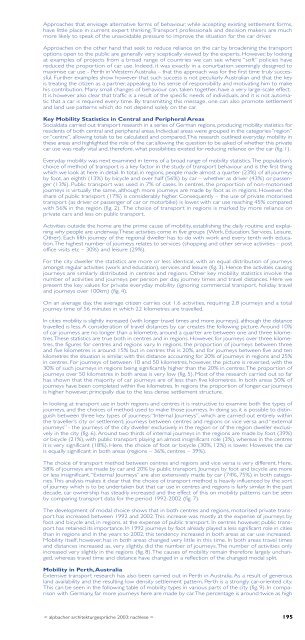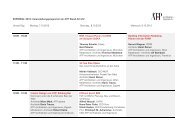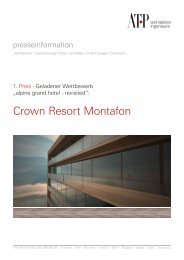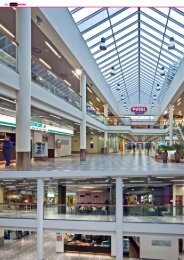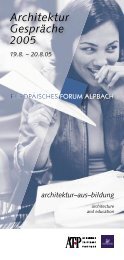alpbacher architekturgespräche 2003 - ATP
alpbacher architekturgespräche 2003 - ATP
alpbacher architekturgespräche 2003 - ATP
Sie wollen auch ein ePaper? Erhöhen Sie die Reichweite Ihrer Titel.
YUMPU macht aus Druck-PDFs automatisch weboptimierte ePaper, die Google liebt.
Approaches that envisage alternative forms of behaviour, while accepting existing settlement forms,<br />
have little place in current expert thinking.Transport professionals and decision makers are much<br />
more likely to speak of the unavoidable pressure to improve the situation for the car driver.<br />
Approaches on the other hand that seek to reduce reliance on the car by broadening the transport<br />
options open to the public are generally very sceptically viewed by the experts. However, by looking<br />
at examples of projects from a broad range of countries we can see where “soft” policies have<br />
reduced the proportion of car use. Indeed, it was exactly in a conurbation seemingly designed to<br />
maximise car use - Perth in Western Australia – that this approach was for the first time truly successful.<br />
Further examples show however that such success is not peculiarly Australian and that the key<br />
is treating the citizen as a partner, appealing to his sense of responsibility and motivating him to make<br />
his contribution. Many small changes of behaviour can, taken together, have a very large-scale effect.<br />
It is however also clear that traffic is a result of the specific needs of individuals, and it is not automatic<br />
that a car is required every time. By transmitting this message, one can also promote settlement<br />
and land use patterns which do not depend solely on the car.<br />
Key Mobility Statistics in Central and Peripheral Areas<br />
Socialdata carried out transport research in a series of German regions, producing mobility statistics for<br />
residents of both central and peripheral areas. Individual areas were grouped in the categories “region”<br />
or “centre”, allowing totals to be calculated and compared.This research outlined everyday mobility in<br />
these areas and highlighted the role of the car, allowing the question to be asked of whether this private<br />
car use was really vital and, therefore, what possibilities existed for reducing reliance on the car (fig. 1).<br />
Everyday mobility was next examined in terms of a broad range of mobility statistics.The population’s<br />
choice of method of transport is a key factor in the study of transport behaviour and is the first thing<br />
which we look at here in detail. In total, in regions, people made almost a quarter (23%) of all journeys<br />
by foot, an eighth (13%) by bicycle and over half (56%) by car – whether as driver (43%) or passenger<br />
(13%). Public transport was used in 7% of cases. In centres, the proportion of non-motorised<br />
journeys is virtually the same, although more journeys are made by foot as in regions. However, the<br />
share of public transport (17%) is considerably higher. Consequently – the use of private motorised<br />
transport (as driver or passenger of car or motorbike) is lower, with car use reaching 45% compared<br />
with 56% in the region (fig. 2). The choice of transport in regions is marked by more reliance on<br />
private cars and less on public transport.<br />
Activities outside the home are the prime cause of mobility, establishing the daily routine and explaining<br />
why people are underway.These activities come in five groups (Work, Education, Services, Leisure,<br />
Other). Each fifth journey of the regional dweller has to do with work and every tenth with education.The<br />
highest number of journeys relates to services (shopping and other service activities – post<br />
office visits etc – 30%) and leisure (29%).<br />
For the city dweller the statistics are more or less identical, with an equal distribution of journeys<br />
amongst regular activities (work and education), services and leisure (fig. 3). Hence the activities causing<br />
journeys are similarly distributed in centres and regions. Other key mobility statistics involve the<br />
number of activities and journeys per person per day, journey times and travel distances. Here we<br />
present the key values for private everyday mobility (ignoring commercial transport, holiday travel<br />
and journeys over 100km) (fig. 4).<br />
On an average day, the average citizen carries out 1.6 activities, requiring 2.8 journeys and a total<br />
journey time of 56 minutes in which 22 kilometres are travelled.<br />
In cities mobility is slightly increased (with longer travel times and more journeys), although the distance<br />
travelled is less. A consideration of travel distances by car creates the following picture. Around 10%<br />
of car journeys are no longer than a kilometre, around a quarter are between one and three kilometres.These<br />
statistics are true both in centres and in regions. However, for journeys over three kilometres,<br />
the figures for centres and regions vary. In regions, the proportion of journeys between three<br />
and five kilometres is around 15% but in centres this is 20%, and for journeys between five and ten<br />
kilometres the situation is similar, with this distance accounting for 20% of journeys in regions and 25%<br />
in centres. For journeys of between 10 and 50 kilometres, however, the picture is reversed, with the<br />
30% of such journeys in regions being significantly higher than the 20% in centres.The proportion of<br />
journeys over 50 kilometres in both areas is very low (fig. 5). Most of the research carried out so far<br />
has shown that the majority of car journeys are of less than five kilometres. In both areas 50% of<br />
journeys have been completed within five kilometres. In regions the proportion of longer car journeys<br />
is higher however, principally due to the less dense settlement structure.<br />
In looking at transport use in both regions and centres it is instructive to examine both the types of<br />
journeys, and the choices of method used to make those journeys. In doing so, it is possible to distinguish<br />
between three key types of journeys:“Internal Journeys”, which are carried out entirely within<br />
the traveller’s city or settlement; journeys between centres and regions or vice versa and “external<br />
journeys” - the journeys of the city dweller exclusively in the region or of the region dweller exclusively<br />
in the city (fig. 6). Around two thirds of internal journeys in the regions are made by foot (39%)<br />
or bicycle (21%), with public transport playing an almost insignificant role (3%), whereas in the centres<br />
it is very significant (18%). Here, the choice of foot or bicycle (30%, 12%) is lower. However, the car<br />
is equally significant in both areas (regions – 36%, centres – 39%).<br />
The choice of transport method between centres and regions and vice versa is very different. Here,<br />
58% of journeys are made by car and 20% by public transport. Journeys by foot and bicycle are more<br />
or less insignificant.“External Journeys” are also extensively made by car (74%, 75%) in both categories.This<br />
analysis makes it clear that the choice of transport method is heavily influenced by the sort<br />
of journey which is to be undertaken but that car use in centres and regions is fairly similar. In the past<br />
decade, car ownership has steadily increased and the effect of this on mobility patterns can be seen<br />
by comparing transport data for the period 1992-2002 (fig. 7).<br />
The development of modal choice shows that in both centres and regions, motorised private transport<br />
has increased between 1992 and 2002.This increase was mostly at the expense of journeys by<br />
foot and bicycle and, in regions, at the expense of public transport. In centres however, public transport<br />
has retained its importance. In 1992 journeys by foot already played a less significant role in cities<br />
than in regions and in the years to 2002, this tendency increased in both areas as car use increased.<br />
Mobility itself, however, has in both areas changed very little in this time. In both areas travel times<br />
and distances increased as, very slightly, did the number of journeys.The number of activities only<br />
increased very slightly in the regions (fig. 8).The causes of mobility remain therefore largely unchanged,<br />
whereas travel time and distance have changed in a reflection of the changed modal split.<br />
Mobility in Perth,Australia<br />
Extensive transport research has also been carried out in Perth in Australia. As a result of generous<br />
land availability and the resulting low density settlement pattern, Perth is a strongly car-oriented city.<br />
This can be seen in the following table of mobility types in various parts of the city (fig. 9). In comparison<br />
with Germany, far more journeys here are made by car.The percentage is around twice as high<br />
< <strong>alpbacher</strong> <strong>architekturgespräche</strong> <strong>2003</strong>: nachlese > 195


